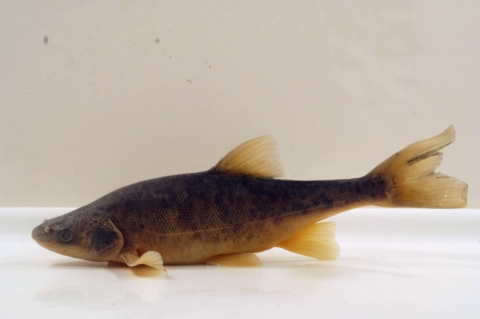Based on a rigorous scientific review, the U.S. Fish and Wildlife Service has determined that the Lower Colorado River basin distinct population segment (DPS) of roundtail chub is not at risk of extinction in the foreseeable future and does not warrant listing under the Endangered Species Act (ESA).
As part of this action, Service biologists have also determined that the Gila chub, protected as endangered under the ESA, should be considered for delisting, based on a 2017 study that revealed the roundtail, headwater and Gila chubs are all a single species. The Service is also asking the public to submit any information relevant to the Gila chub and its habitat in order to better inform a forthcoming proposal to remove it from the ESA.
In determining the status of the Lower Colorado River roundtail chub, Service biologists determined that the primary threats to it are non-native species and alterations to natural stream flows, which have reduced the distribution and abundance of the chub in the past and continue to affect populations today. These threats may also be exacerbated by climate change climate change
Climate change includes both global warming driven by human-induced emissions of greenhouse gases and the resulting large-scale shifts in weather patterns. Though there have been previous periods of climatic change, since the mid-20th century humans have had an unprecedented impact on Earth's climate system and caused change on a global scale.
Learn more about climate change in the future. However, these threats do not pose a risk of extinction for the species, in part due to long-term conservation and land management efforts by stakeholders.
Recognized as a potentially sensitive species, many federal, state and county agencies and Tribal nations have initiated best management practices and conservation commitments for the species and its habitat. These conservation efforts have stabilized roundtail chub populations. Currently, Service biologists estimate that roundtail chub populations are distributed across 34% of its historical range in the Lower Colorado River basin, and most of the existing populations are considered stable or increasing according to monitoring data, despite the co-occurrence of non-native species across much of the range.
The Service and partners will remain engaged in the conservation status of the roundtail chub and the ecosystem it depends on. Established in 2004, the Three Species Conservation Team is a rangewide partnership of seven state fish and game agencies, federal land management agencies (including the Service) and Tribes working together to monitor and conserve the roundtail chub, bluehead sucker and flannelmouth sucker.
The roundtail chub is a member of the carp and minnow family. Adults can vary in size from 4 to 20 inches in length, and their lifespan can exceed 10 years. They are omnivorous, feeding on plant material, invertebrates, fish, frogs and even lizards.
Today’s finding will publish in the Federal Register on April 5, 2022 under Docket No. FWS-R2-ES-2022-0001. Images and other information on the Lower Colorado River DPS of roundtail chub are available at digitalmedia.fws.gov. The Service remains interested in information regarding the status and conservation of, and any potential threat to, the roundtail chub and the Gila chub. Please submit information by email to incomingazcorr@fws.gov.




